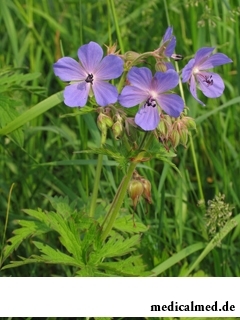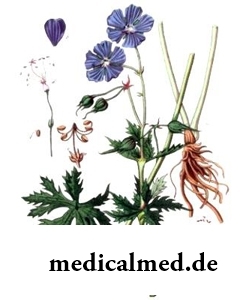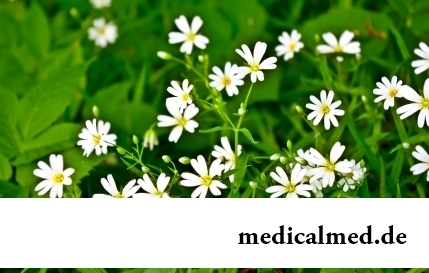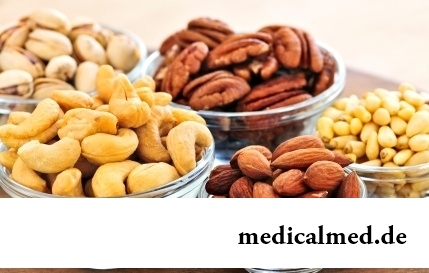





The geranium is meadow
Application instruction:
 Geranium meadow – the perennial plant belonging to family Geranaceous.
Geranium meadow – the perennial plant belonging to family Geranaceous.
Description, places of growth
The plant has a short rhizome. The land escapes branching, strong. Stalks in an upper part well leaf-bearing. Radical leaves have pochkovidno-roundish plates from 6 to 12 cm long, seven-separate almost to the basis, dlinnochereshkovy, have the plumose made an incision shares. Stem leaves it is less by the sizes, with shorter scapes, five-separate. Upper leaves sedentary, three-separate.
Flowers numerous, zontichnoobrazny. On each peduncule about two flowers of a large correct form which are widely opened are located. During blossoming are directed by the opened part up, and before blossoming hang.
The plant yields the korobochkoobrazny fruits which when maturing are breaking up to five one-seeded parts.
The geranium meadow prefers meadow areas, valleys of the mountain rivers, deciduous, sometimes softwood forests, and also wet forest glades.
It is widespread in Central Asia, in Western Siberia (except Daursky district), in Belarus, in Ukraine (except the Crimea), in the Siberian Arctic (lower reach of the Yenisei River), in the European part of Russia, in the Arctic (The Murmansk coast, the European Arctic).
The grass (flowers, leaves and stalks) and roots of a geranium meadow are applied in medical the purposes.
Chemical composition
Roots of a plant contain starch, carbohydrates, tannins, flavonoids, catechins, fenolkarbonovy acids, triterpenovy saponins.
Leaves, stalk and flowers of a plant contain sucrose, fructose, glucose, saponins, raffinose, alkaloids, carotene, ascorbic acid, vitamin K, flavonoids, leykoantotsiana and anthocyans, tannins.
Use and useful properties
 Tannins in a plant have antibacterial action. Extract of an elevated part of a plant, depending on a dosage, is capable to render as oppressing, and exciting action on a nervous system, has anti-toxic effect against snake poisons.
Tannins in a plant have antibacterial action. Extract of an elevated part of a plant, depending on a dosage, is capable to render as oppressing, and exciting action on a nervous system, has anti-toxic effect against snake poisons.
The geranium meadow in traditional medicine as antiinflammatory, knitting and disinfectant found the application, at fractures of bones, and also at treatment of tumoral diseases.
Infusion or broth of a grass or roots of a plant helps at epilepsy, fever, sleeplessness, catarrhal and gastric diseases, at gastritis, hemorrhoidal bleedings, enteritis.
The grass is applied in the form of infusion, broth or powder to lotions and powders at it is long not healing wounds, abscesses, ulcers, at gouty and rheumatic joint pains, and also for rinsing at quinsies, ulites and stomatitises.
Infusion of a grass is accepted at gout and rheumatism, an urolithiasis, at tachycardia, stenocardia, some female diseases, itch, for treatment of diseases of a respiratory organs.
Broth of a grass will caress hair at an alopecia.
Roots in the form of broth are effective at dyspepsia and dysentery, and the crushed roots are effective at caries.
The fresh pounded leaves of a plant put to places of stings of snakes.
Contraindications
Use of a geranium meadow at the increased viscosity of blood, thrombophlebitises and thromboses, at senile locks is not recommended, to an intestines atony, at gastritis and a hyperoxemia.
The educated person is less subject to brain diseases. Intellectual activity promotes formation of the additional fabric compensating sick.

Tea is loved and use almost everything. This drink has tonic properties, contains the tannins capable podavlit...
Section: Articles about health
Zone hypostases under eyes - very widespread problem giving to people is a lot of inconvenience. Hypodermic fabric in these parts has very loose structure and almost does not contain collagenic fibers. Besides, the skin covering подглазья constantly is exposed...
Section: Articles about health
Long time antibiotics were considered as a panacea from all diseases and were appointed even at insignificant symptoms of an infection. Even now not everyone knows in what force of antibiotics how and when they should be accepted. Let's discredit 7 popular myths about such drugs....
Section: Articles about health
Statistically cystitis 25-30% of women up to 40 years have. With age this indicator raises, besides many do not get in to become...
Section: Articles about health
Smack in a mouth can arise in the natural way – as a result of lack of morning hygiene or reception of the corresponding food. However in certain cases its existence is a sign of certain pathologies, and allows to reveal an illness at an early stage. In we depend...
Section: Articles about health
Bulimia and anorexia, are heavy deviations of a feeding behavior, become a cause of death of patients much more often than all other nervous breakdowns combined. In 60% of cases two illnesses accompany each other: patients feel horror before danger of set of excess weight and try to refuse as often as possible food, but periodically suffer from attacks of sudden hunger and an uncontrollable overeating. Each patient with anorexia and bulimia needs the help qualified пс...
Section: Articles about health
The mankind knows that some toxins at intake in the minimum quantities have therapeutic effect...
Section: Articles about health
Wood louse – the ordinary-looking unpretentious plant extended in all territory of our country. It quickly expands, and sometimes fills sites, bringing a lot of chagrin to gardeners. Perhaps, they would be upset less if knew that the wood louse is the prices...
Section: Articles about health
Residents of big cities quite often have a disease which is known as the syndrome of chronic fatigue (SCF) today. This illness affects the people belonging to various social and demographic groups and living on all continents. Most of all SHU are subject women aged from 25 up to 45 years. Statistically, the number of cases fluctuates in the different countries from 10 to 37 people on 100 thousand, but specialists believe that these figures are significantly underestimated as people, страдающ...
Section: Articles about health
Coffee – favourite drink of many. For the last decades it more than once already declared very harmful, extremely useful and even...
Section: Articles about health
When overcomes feeling of hunger, and an opportunity to have dinner fully is absent, having a snack − the meals, small on volume, stabilizing sugar level in blood comes to the rescue. The relation of nutritionists to having a snack is more often negative, but only because in кач...
Section: Articles about health
Life of the modern child is extremely active and difficult. Information strain which is experienced by the school student and did not dream pupils of last times. Careful parents, wishing well to the children, will organize a set of additional classes in circles, sports sections and music schools. In such situation the child needs continuous care and good nutrition to keep health and high performance....
Section: Articles about health
The way of life of people promptly changes from year to year: if about ten years ago the personal computer was not in each family...
Section: Articles about health
The metabolism at each person proceeds in own way. However between the speed of this process and disposal of excess weight after all all have a dependence. Unfortunately, the people inclined to try on itself numerous "miracle" diets, not always at...
Section: Articles about health
To look healthy and means well-groomed not only to be pleasant to people around, but also to feel strong, sure and taken place. Specialists in the field of cosmetology quite often note that not all women are able to look after face skin. Many women incorrectly apply cosmetics, ineptly use various procedures, without having exact information on their real influence and dividing numerous delusions about it. All this not the best...
Section: Articles about health
Radiological methods of a research are applied in medicine more than hundred years, and thanks to them millions of lives were saved. In m...
Section: Articles about health
All the known slogan "Protect Men!" arose not from scratch. In a sense, the nature created men much less adapted for vital disorders, than it seems at first sight. Statistically, men are ill more often...
Section: Articles about health
About influence of fasting days on an organism it is told much – both about advantages, and about shortcomings. It is considered that fasting day in the form of a short-term monodiet is useful, promoting effective removal of slags from an organism whereas irregular, excessively long, spontaneous fasting days lead only to deterioration in health. How to derive benefit from the sparing diet and not to do much harm to itself? Let's consider the main advantages and shortcomings of fasting days and their influence on an org...
Section: Articles about health
Not without reason doctors say that 90% of diseases begin or develop because of misoperation of intestines. Disturbance of its functions связ...
Section: Articles about health
Popular joke that there are no healthy people, and is nedoobsledovanny, most of us considers an honest truth, continually it is necessary to hear that all of us are sick hardly from a school bench. It is hard to say, whether so it actually because...
Section: Articles about health
The fatigue, sleep debt, disturbances of food, bad mood, vagaries of the weather – all these circumstances badly affect our appearance. Especially the person suffers: skin becomes flabby, loses healthy color, becomes covered by wrinkles, zones of hypostases and dark circles under eyes appear. It is not always possible to be saved from influence of aggressive factors, but we are quite able to minimize its effects. For this purpose usually apply the cosmetics and procedures helping увлаж...
Section: Articles about health
The problem of diagnosis was and remains to one of the most important in medicine. From that, the reason недо will be how precisely defined...
Section: Articles about health
A little more than a century ago goat milk was a traditional food stuff of most of Russians. Unfortunately, today on tables of our compatriots it appears extremely seldom. The reason that the use of so useful product practically descended on...
Section: Articles about health
Heart disease and blood vessels lead to disturbance of blood supply of bodies and fabrics that involves failures in their work, deterioration in health of the person, decrease in its working capacity and standard of living. Annually more than 17 million inhabitants of our planet perish from pathologies such....
Section: Articles about health
Statistically, can only one of ten of our compatriots brag of a decent condition of an oral cavity. On среднестатистич...
Section: Articles about health
The thought that the mass of their body is too big at least once in life visits from 80 to 95% of women. Many women are so obsessed with this idea that constantly try all new and new ways of weight reduction. Considerable part of these method...
Section: Articles about health
Obesity is called a disease of 21 centuries, for the last 100 years the number of the people suffering from excess body weight considerably increased. Statistically, on Earth already about 1,5 billion corpulent people, and 500 million from them have the extreme degree of completeness negatively affecting quality and duration of their life. What served as the reason of growth of stout persons on the planet? How not to get to their ranks? Let's consider five main premises for increase in body weight in conditions современнос...
Section: Articles about health
